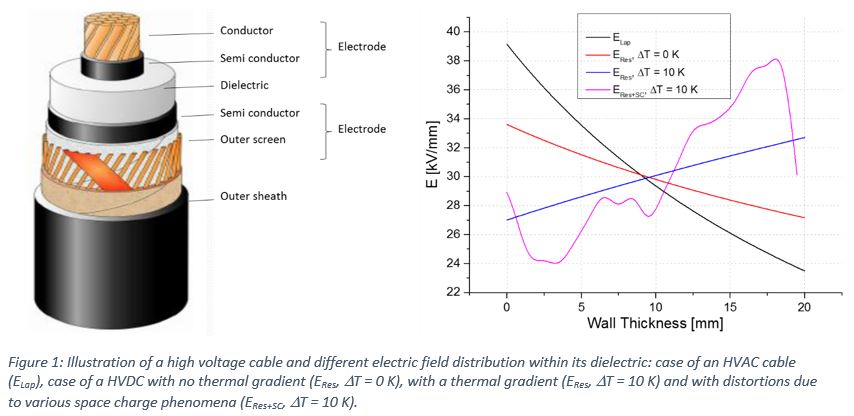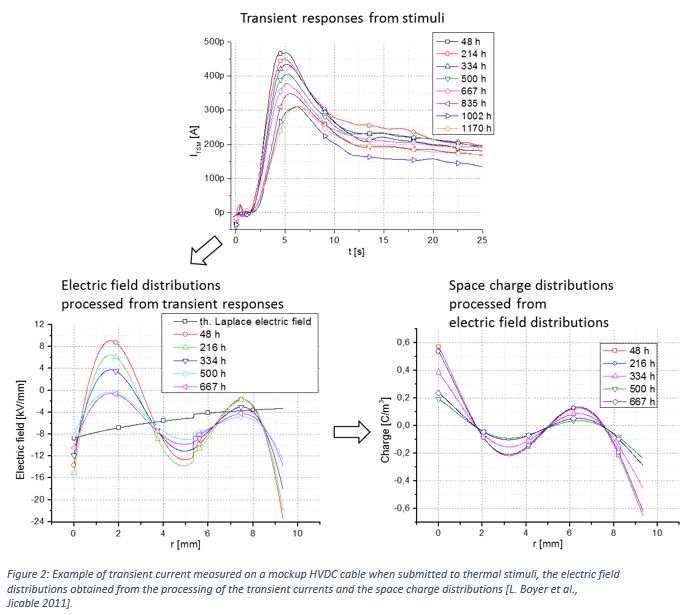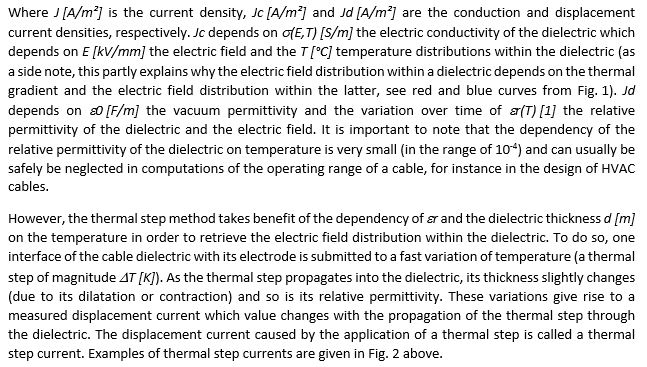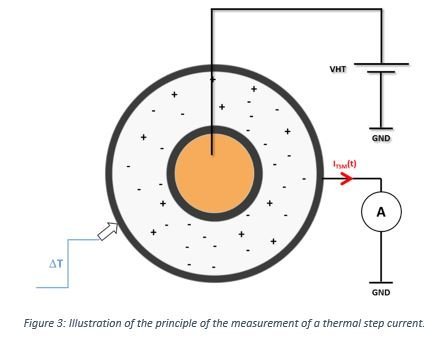Space charge measurements on cable dielectrics
Electric field evolution in a cable dielectric
When a voltage is applied to a cable, electric charges are established in its electrodes, inducing an electric field in the dielectric. This electric field implies that the cable is submitted to an electrical stress which, under certain circumstances induces an accelerated ageing of its dielectric which may be followed by its breakdown.

In HVAC applications, the electric field distribution in a cable dielectric only depends on its inner and outer radius. It is thus constant. In this case, provided that one knows the maximum electric field sustainable by the dielectric, its thickness can be optimally set for safe operation during several decades.
However, in HVDC applications, the electric field distribution in a cable dielectric does not only depends on its geometry and the applied voltage but also on its temperature gradient, on its morphology, on its manufacturing process, on the nature of the contacts between the dielectric and its surrounding semiconductors, and so on. Furthermore, due to these dependencies, electric charges can be transferred from the cable conductor and metallic screen into and out of the dielectric. These charges can then move or be trapped inside the dielectric. The same goes for electric charges already present in the cable dielectric due to manufacturing process. The movement of electric charges, their trapping and de-trapping mechanisms depend on the temperature and on the electric field itself. It is thus difficult to estimate the electric field distribution in a HVDC cable dielectric and it is even more difficult to predict its evolution during the operational life of the cable.
Extensive studies on dielectric submitted to DC voltages have been conducted to achieve a better apprehension of the evolution of the electric field and space charges over time. In most of these studies, space charge measurements were performed [A. Toureille, SFE 2010].
Space charge measurements
Space charge measurements usually refers to the measurement techniques aiming at getting the electric charges and electric field distributions inside a dielectric of a studied sample and are usually nondestructives.
Nondestructive space charge measurement techniques are indirect and based on a stimulus. For instance, the stimulus may be a temperature or a pressure variation applied to one part of the studied sample. The response of the sample to the stimulus will either be a transient current or voltage. The measured electrical value will then be processed in order to retrieve the space charge or the electric field distribution [S. Holé, IEEE 2008].

When applied to electrical cables, the most widely used space charge measurement methods are the Pulse Eelctro-Acoustic (PEA) method and the Thermal Step Method (TSM). [A. Tzimas et al., ICD 2016]. The Thermal Step Method is described below.
When electrical charges move through a medium, an electrical current can be measured. A measured current density is a measured current per area unit. With simplifications, it can be written as follow:


Assuming that the electric field distribution in the cable dielectric does not change during the application of a thermal step, a link can be made between the measured thermal step current over time, the propagation of the thermal step through the dielectric during the measurement and the electric field distribution. The link is given by the following equation [P. Notingher et al., IEEE 2009].


The extraction of the electric field distribution within the dielectric from the measured thermal step current and the above equation requires a rather complex processing which will not be described here. The reader can refer to [P. Notingher et al., IEEE 2009] for more details.
The thermal step method has been successfully used in the cable industry laboratories, first on mockup prototype cables [J. Castellon et al., IEEE 2009], then on full size final cables [L. Boyer et al., Jicable 2015]. Carefully chosen magnitudes of thermal steps insures that the measurement do not change the electrical state of the cable, that is no evolution of the space charge distribution within the dielectric. It is thus possible to follow the evolution of the electric field distribution within a cable dielectric during accelerated ageing campaigns [A. Tzimas et al., ICD 2016]. It is thus possible, through ageing campaigns in laboratory conditions on full size cables, to acquire a better apprehension of evolution of the electric field distribution and the electrical ageing of a given HVDC cable technology when used in-field.
However, the concern with accelerated ageing campaigns in laboratory is that the triggered ageing phenomena may not be similar to what the cable would be submitted to in-field, which brings uncertainties over the expected evolutions of the electric field distribution in the cable dielectric during its ageing. The ultimate goal would thus be to be able to monitor the evolution of the electric field distribution in a cable dielectric when used in-field. A first step toward this goal has recently been made [A. Darkawi, PhD thesis 2013].


